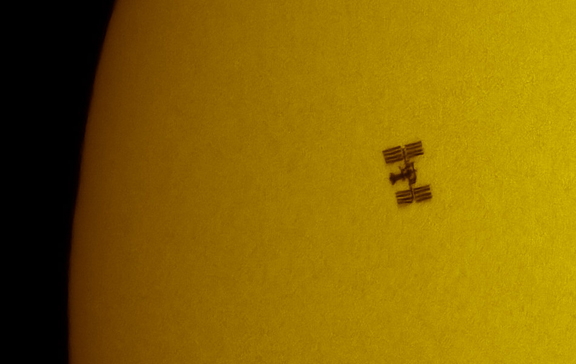I know that I’ve probably mentioned the International Space Station (ISS) a hundred times in the posts of this blog. I also know that I’ve shown at least a score of pictures of the ISS, and of course you can easily find a thousand images of the ISS on the web. The image below is of the ISS.

But have you ever seen the Space Station itself, with your own eyes as it streaks across your sky shortly after sunset or shortly before dawn. Well with a little help from NASA it’s really pretty easy. I know because I’ve seen it myself close to fifty times by now.
Now the orbit of the ISS is inclined to the Earth’s equator at an angle of 51.56º so sooner or later it will pass over every point on Earth between latitudes 51.56ºN and 51.56ºS. That means that the ISS regularly flies right over the head nearly 80% of the human race.
But you can’t see it during the daytime, the brightness of the Sun will simply drown it out. And you can’t see it in the middle of the night either because it will be in the Earth’s shadow and therefore not illuminated. You have to catch it during the short periods of time when you on the Earth’s surface are in darkness but 400 kilometers above you the station is still in the sunshine.
But don’t worry, NASA’s already done all of the work for you, and the right conditions happen fairly frequently. Before you go to NASA’s site however let me give you a few hints about seeing the station. First of all you’re going to need a clear sky, I hope that doesn’t surprise anyone. You’re also going to need to know the directions of the compass at your viewing place, that is you’ll need to know what direction is North, South, East and West. Another important thing to keep in mind is to try to get away from trees and buildings. You want to be able to see as much of the sky as you can!
Click on the link provided below to be taken to the space agency’s “Spot the Station” website.
https://spotthestation.nasa.gov/
Now when you get to the “Spot the Station” site at the top of the page in the middle you’ll see Spotting Opportunities”, click on that to be taken to another page with a map of the world. Successively clicking on your location will eventually get you to the calculated position closest to your home. For me that is Independence Hall in Philadelphia, see image below.

Looking at the table in the lower right of the image you can see that there are five columns. The first column is labeled Date, giving the date and time that the ISS will become visible where you are. You can see that for Philadelphia there are quite a few opportunities.
The second column is Visible, which tells you for how long the ISS will be visible.
The third column is Max Height: this tells you the maximum elevation, in degrees that the ISS will attain during that sighting. Now the horizon itself is 0º and 90º is straight up. Obviously the larger the Max Height the easier the ISS will be to spot but I have seen on occasion when it when it got no higher than 15º.
The fourth column is labeled Appears. This tells you both the compass heading and the height in degrees above the horizon of the point where the station will appear. As a good rule of thumb, your fist held at arms length is about 10º so if the station is going to appear 20º above the west lets say, that’s two fists above the horizon in the western sky.
The fifth and final column is Disappears, this is identical to Appears except that this is where the ISS will vanish
So what does the ISS look like as it passes overhead? Well to me it looks like a very bright, silvery star that moves quite fast across the sky. The glow of the ISS is steady, there’s no blinking lights as with an airplane.
If you have binoculars, and a steady hand, the ISS will become a definable object, small but no longer just a point. There are even amateur astronomers who have succeeded in photographing the ISS from the ground. I’ll leave you today with one such image of the station silhouetted against the Sun, and if you look close you can see that the space shuttle is docked there. Good luck in trying to catch the International Space Station.


What’s up, this weekend is good in favor of me, since this time i am reading this fantastic informative article
here at my house.
Thanks for the comment and come back soon!
Bob L
When I originally commented I clicked the “Notify me when new comments are added” checkbox and now each time a comment is added I get four emails with
the same comment. Is there any way you can remove
me from that service? Thank you!
Thanks for the comment and come back soon!
Bob L